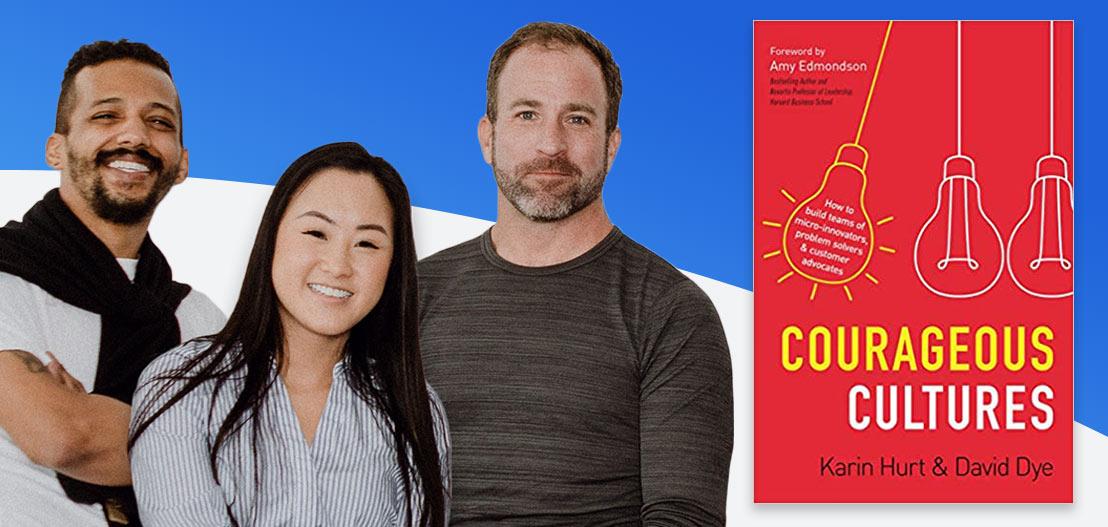Courageous Cultures by Karin Hurt and David Dye explains how to use the principles of psychological safety to combat what they call “the fear of speaking up” (FOSU) and ensure that the best ideas are being surfaced and implemented for organizational success. Here are three of their most compelling ideas and a few suggestions on how to bake them into the day-to-day operations of your HR team and your company at large.

Big Idea 1: People have a fear of speaking up
By our very nature, people are highly attuned to risk, especially interpersonal risk. A single negative experience with speaking up can result in an employee deciding to never do so again. Hurt and Dye identify five primary reasons that people don’t share their ideas:
- People don’t think leadership wants their ideas.
- No one asks.
- They lack the confidence to share.
- They lack the skills to share effectively.
- People don’t think their feedback will be implemented, so they don’t bother.
To combat this tendency, leaders must cultivate an environment where it’s clear that employees’ ideas are not only welcomed, they’re encouraged. Micro-innovators, problem solvers, and customer advocates exist in your organization, but without a culture that encourages them to share their ideas and makes sharing safe, those ideas will languish.
Possible use case in your job:
Assess your team and your company’s approaches to inviting feedback. Do the people with the most power respond positively or defensively when someone makes a recommendation or shares an idea? How could they handle that better? Have you considered gathering feedback anonymously?
If finding the micro-innovators and problem-solvers that are going to help your organization grow in the first place is something you’d like help with, check out this guide for a better approach to assessing what your candidates can (and want to) do.

Big Idea #2: A culture of openness is built on trust and curiosity
Hurt and Dye describe something they call the Courageous Culture Cycle, that moves from phases of clarity to phases of curiosity and back. To create clarity, they write, leaders need to first build a foundation of safety, direction, and confidence. Then once that security is established, they should strive to cultivate curiosity by intentionally seeking out ideas, engagement and solutions.
To create clarity, leaders should go out of their way to answer key employee questions that are sometimes verbalized, and sometimes not. For example:
- What do you actually mean?
- Why does it matter?
- Can I trust you?
- What is expected of me?
To cultivate curiosity, Hurt and Dye write, leaders shouldn’t simply ask for suggestions and pat themselves on the back for reaching out. It’s also important to spark thinking and sharing by asking targeted questions and being open to receiving difficult feedback. Here are a few questions that can help you get to the heart of the matter in a variety of contexts:
- What is the problem we have that no one talks about?
- What do you think we could do differently next time to help this project (or person) succeed?
- What recommendations do you have before we start on this conversion?
- What are you most afraid of with this program/project/process?
- What is the biggest source of conflict you’re having working with X department? (How might we be contributing to the issue?)
- What’s sabotaging our success?
Possible use case in your job:
In your own department, build time into your weekly and monthly meeting schedules for giving and receiving meaningful feedback—and consider making a short “post-mortem” session the last step for any major initiative.
No need to cover everything every time: keep things simple by focusing on just one or two of the questions above as prompts. Then, after you’ve added this layer to your own team’s routine, think about what worked well and what didn’t and consider proposing ways for company leadership to incorporate better feedback-gathering methods too.

Big Idea 3: It’s important to respond with regard…even when you don’t like an idea
Apathy, avoidance, and poor reactions to off-base ideas can damage the safe space you’ve worked to build. So even if someone’s idea is off-base, make sure those who have been brave enough to speak up know that their ideas are appreciated and valued.
Possible use case in your job:
Make receiving ideas, both helpful and not-so-helpful ones, a deliberate practice. Make a concerted effort to fully understand people’s suggestions before making a judgment; thank them for sharing, regardless of whether the idea was “good” or “bad;” and explicitly invite them to share ideas in the future. Just because someone’s first idea isn’t useful doesn’t mean their second or third ideas won’t be.
And that’s a wrap! To dig a little deeper, check out the book at your local library, or buy it at Alibri, or Amazon.
Also, you can follow Karin Hurt on Twitter and LinkedIn and David Dye on Twitter and LinkedIn. Thanks for reading!






